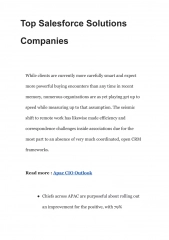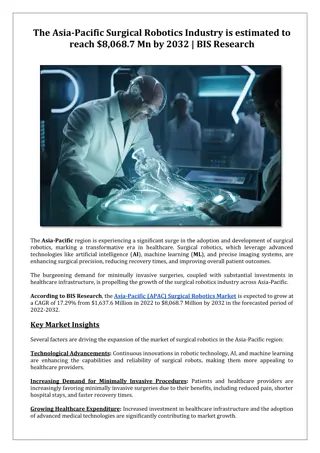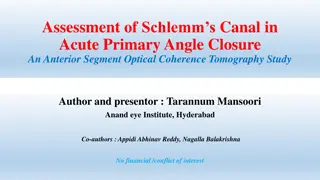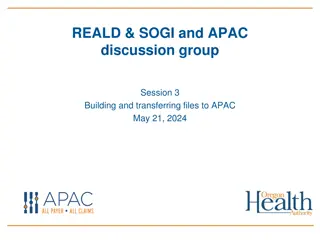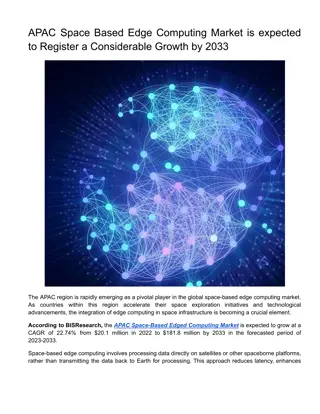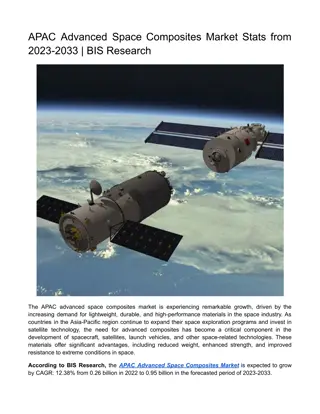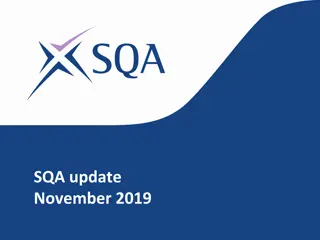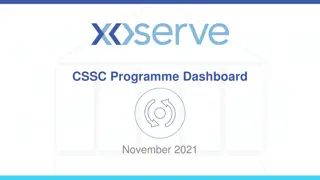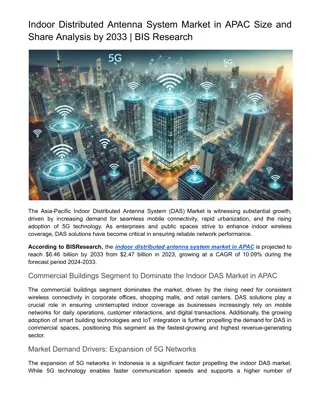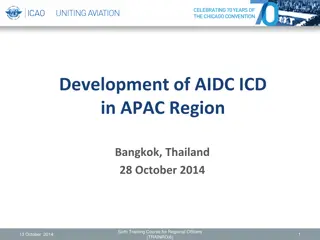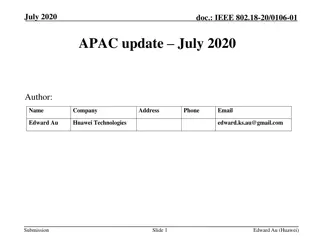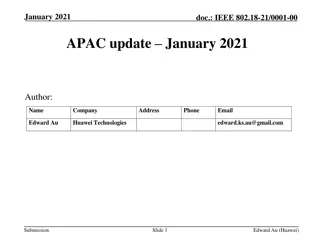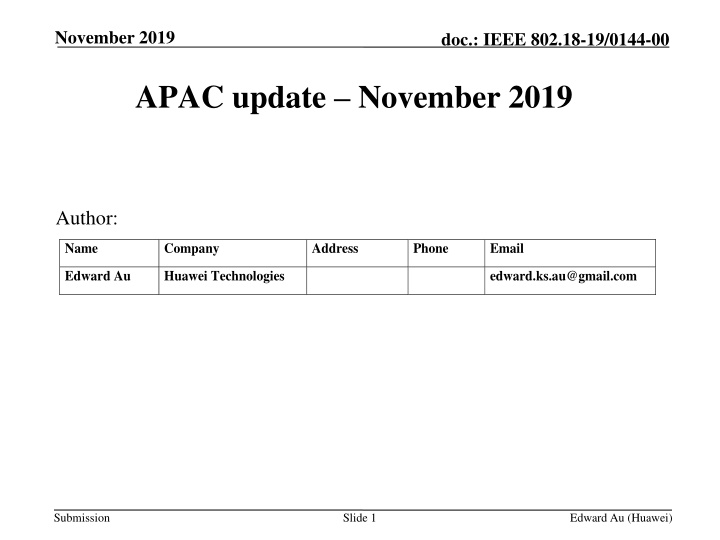
APAC Wi-Fi and WPAN Activities Overview November 2019
This document provides insights into the APAC region's activities related to Wi-Fi and WPAN between September and November 2019. It covers consultations on spectrum sharing in Australia, compliance priorities, and updated short-range device requirements in Indonesia. The slides presented by Edward Au highlight key submissions and technical characteristics essential for those involved in the telecommunications sector.
Download Presentation

Please find below an Image/Link to download the presentation.
The content on the website is provided AS IS for your information and personal use only. It may not be sold, licensed, or shared on other websites without obtaining consent from the author. If you encounter any issues during the download, it is possible that the publisher has removed the file from their server.
You are allowed to download the files provided on this website for personal or commercial use, subject to the condition that they are used lawfully. All files are the property of their respective owners.
The content on the website is provided AS IS for your information and personal use only. It may not be sold, licensed, or shared on other websites without obtaining consent from the author.
E N D
Presentation Transcript
November 2019 doc.: IEEE 802.18-19/0144-00 APAC update November 2019 Author: Name Company Address Phone Email Edward Au Huawei Technologies edward.ks.au@gmail.com Submission Slide 1 Edward Au (Huawei)
November 2019 doc.: IEEE 802.18-19/0144-00 Background This slide deck provides a high-level overview of the activities in APAC (related to Wi-Fi and WPAN) between September and November 2019. Submission Slide 2 Edward Au (Huawei)
November 2019 doc.: IEEE 802.18-19/0144-00 Australia ACMA (1) Consultation on Spectrum Sharing: Overview and New Approaches Closed on September 27, 2019 https://www.acma.gov.au/consultations/2019-10/new- approaches-spectrum-sharing-consultation-252019 To provide an overview of spectrum sharing concepts as they currently exist and outline new approaches to spectrum sharing arrangements, including examples of sharing arrangements being either introduced or considered internationally. This is intended to provide a common information base against which new proposals for spectrum sharing can be considered. List of submissions: https://www.acma.gov.au/sites/default/files/2019-11/ifc-25-2019- submissions.zip Slide 3 Submission Edward Au (Huawei)
November 2019 doc.: IEEE 802.18-19/0144-00 Australia ACMA (2) Consultation: Compliance priorities 2020 to 2021 Submission deadline: December 5, 2019 https://www.acma.gov.au/consultations/2019-11/compliance- priorities-2020-2021-consultation Note the compliance priorities for 2019 to 2020 are as follows: Telco consumer safeguards Small cell base stations for 4G and 5G Unsolicited communications News Gambling Interference and licencing compliance Submission Slide 4 Edward Au (Huawei)
November 2019 doc.: IEEE 802.18-19/0144-00 Indonesia MCIT (1) Short range device requirements are updated since July 2019: https://sertifikasi.postel.go.id/home/news?id=65 SRD consists of the following categories: (a) Bluetooth (b) Telecommunication device with transmit power less than 10mW (commonly called low power device) (c) RFID (d) NFC (e) IEEE 802.15.4 based WPAN (f) Intelligent transport system (g) Other SRD telecommunication equipment Submission Slide 5 Edward Au (Huawei)
November 2019 doc.: IEEE 802.18-19/0144-00 Indonesia MCIT (2) Short range device requirements are updated since July 2019 (Cont d): https://sertifikasi.postel.go.id/home/news?id=65 Technical characteristics and conformance requirement of IEEE 802.15.4 based WPAN is shown in page 14. It does not explicitly mention WLAN but it would be parts of Other SRD telecommunication equipment operating at the frequency bands as listed in pages 15 - 19, including 920-923 MHz, 2400-2483.5 MHz, 5150-5250 MHz, 5250-5350 MHz, 5725-5825 MHz. Submission Slide 6 Edward Au (Huawei)
November 2019 doc.: IEEE 802.18-19/0144-00 Japan MIC (1) Update on the technical conditions of radar systems operating at 60 GHz band http://www.soumu.go.jp/menu_news/s- news/01kiban14_02000401.html Submission Slide 7 Edward Au (Huawei)
November 2019 doc.: IEEE 802.18-19/0144-00 Existing Technical Conditions (as shown in IEEE 802.11-15/0594r0) Maximum antenna power of 10 dBm Antenna power in excess of 10 dBm Frequency band 57-66GHz 57-66GHz Unit channel Not specified Not specified Radio channel Not specified Not specified Antenna power 10 dBm max. More than 10 dBm and not in excess of 24 dBm Equivalent isotropic radiated power Not specified 40 dBm max. If the antenna power is in excess of 10 dBm, 10dBi or more in the direction of emission. Antenna gain 47 dBi max. Modulation system Not specified Not specified Carrier sense Not specified Must incorporate an interference reduction with a carrier sense. Occupied bandwidth Not specified up to 9 GHz. Not specified up to 9 GHz. 55.62 GHz max.: -30 dBm/MHz max. More than 55.62 GHz and not in excess of 57 GHz: -26 dBm/MHz max. More than 66 GHz and not in excess of 67.5 GHz: -26 dBm/MHz max. More than 67.5 GHz: -30 dBm/MHz max. 55.62 GHz max.: -30 dBm/MHz max. More than 55.62 GHz and not in excess of 57 GHz: -26 dBm/MHz max. More than 66 GHz and not in excess of 67.5 GHz: -26 dBm/MHz More than 67.5 GHz: -30d Bm/MHz max. Allowable value of unwanted emission intensity Allowable deviation of antenna power 50% upper limit and 70% lower limit 50% upper limit and 70% lower limit Allowable deviation of frequency Specified frequency band or 500 ppm Specified frequency band or 20 ppm Limit of secondary radio waves emitted from receiving devices Less than 1 GHz: 4 nW/100 kHz max. 1 GHz min.: 20 nW/1 MHz max. 1 GHz min.: 4 nW/100 kHz max. 1 GHz min.: 20 nW/1 MHz max. Submission Slide 8 Edward Au (Huawei)
November 2019 doc.: IEEE 802.18-19/0144-00 Proposed Technical Conditions mmW radar without carrier sense mmW radar with carrier sense Low power data communications Usage Radiolocation Radiolocation Data communications Frequency band 57-64 GHz 57-66 GHz Antenna power 10 dBm max. Not exceed 24 dBm max. Equivalent isotropic radiated power 13 dBm max. 40 dBm max. Antenna gain Not specified 10 dBi above Modulation system Frequency modulation, continuous wave Not specified Occupied bandwidth 7 GHz 9 GHz 55.62 GHz max.: -30 dBm/MHz max. More than 55.62 GHz and not in excess of 57 GHz: -26 dBm/MHz max. More than 64 GHz and not in excess of 67.5 GHz: -26 dBm/MHz More than 67.5 GHz: -30dBm/MHz max. 55.62 GHz max.: -30 dBm/MHz max. More than 55.62 GHz and not in excess of 57 GHz: -26 dBm/MHz max. More than 66 GHz and not in excess of 67.5 GHz: -26 dBm/MHz max. More than 67.5 GHz: -30 dBm/MHz max. No change from the current technical conditions Allowable value of unwanted emission intensity Within 10% of the time, during which radio waves can be emitted within 33 milliseconds Should have a function to stop the emission of the waves Others Carrier sense Allowable radio wave exposure to human body (power density) 2mW/cm2 per 1cm2 of any body surface By identifying the modulation method and other characteristics of the received radio wave, it is possible to distinguish between the reflected wave of the radio wave transmitted by the local station and the radio wave transmitted by another wireless station. Interference avoidance The high frequency section and modulation section cannot be opened easily. In addition, when the high-frequency unit and the modulation unit are housed in separate cases, measures must be taken to maintain the identity of the transmitter and these two units cannot be opened easily. Conditions required for the system Submission Slide 9 Edward Au (Huawei)
November 2019 doc.: IEEE 802.18-19/0144-00 Philippines DICT DICT holds nationwide simultaneous Free Wi-Fi for All launch https://dict.gov.ph/dict-holds-nationwide-simultaneous-free-wi-fi- for-all-launch/ 32 Internet sites across 17 regions in the Philippines were simultaneously launched on October 8 through the Department of Information and Communications Technology s Free Wi-Fi for All program. Submission Slide 10 Edward Au (Huawei)
November 2019 doc.: IEEE 802.18-19/0144-00 Vietnam MIC (1) MIC seeks comments from the public on the compulsory standardsapplied on digital signatures and digital signature authenticationservices on mobile devices Closed on November 5, 2019 https://dict.gov.ph/dict-holds-nationwide-simultaneous-free-wi-fi- for-all-launch/ Best-effort translation: Submission Slide 11 Edward Au (Huawei)
November 2019 doc.: IEEE 802.18-19/0144-00 Vietnam MIC (2) In 2016, Vietnam MIC circulated a draft that revises the regulation onlicense-exempt frequency bands. It is now effective and thedetail is available at: http://mic.gov.vn/Pages/VanBan/14306/1_VBHN-BTTTT.html Selected highlights: Increase the maximum RF output power allowed of WLAN devices operating at 2.4 GHz up to 200mW. Wide Band Communication Device is a radio device that is used in IMT-Advanced wideband transmission applications using the bands 5150-5350 MHz and 5470-5850 MHz at the bandwidth of at least 20 MHz or for access with the rate of up to Gigabit/s in WLAN or WPAN operating in the 57- 66 GHz frequency band. Submission Slide 12 Edward Au (Huawei)
November 2019 doc.: IEEE 802.18-19/0144-00 Vietnam MIC (3) Selected highlights (Cont d) WLAN devices can operate at the following bands: 2400 - 2483.5 MHz, 5150 - 5250 MHz (indoor only), 5250 - 5350 MHz (subject to DFS/TPC), 5470 - 5725 MHz (subject to DFS/TPC), 5725 - 5850 MHz, and 57- 66 GHz. Updated regulation on devices with operating frequency up to 246 GHz including automotive radars and UWB devices. Replace the operating frequencies of RFID from 920-925 MHz to 918-923 MHz band. Remove the operating frequencies of 866 ~ 868 MHz allocated for RFID. The RFID products operating at these bands which have been manufactured or imported before enforcing date of this Circular can still be used in Vietnam, but must be stopped if cause harmful interference to licensed bands. Submission Slide 13 Edward Au (Huawei)

